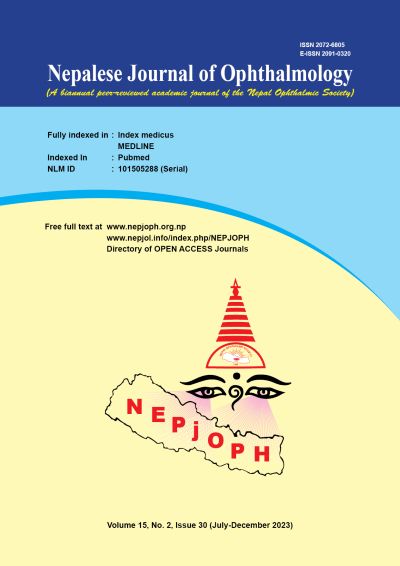Post-Coronavirus Disease-2019 Rhino-orbital Mucormycosis: A Case Report
DOI:
https://doi.org/10.3126/nepjoph.v15i2.46954Keywords:
Mucormycosis, rhino-orbital-cerebral mucormycosisAbstract
Background: Rhino-orbital-cerebral mucormycosis (ROCM) is a rare, opportunistic, angio-invasive, and fatal infection caused by mold fungi of the genera Rhizopus, Mucor, and Rhizomucor. The global incidence of ROCM is 0.005-1.7 per million, with a fatality rate of 46%. Early diagnosis and treatment are crucial for this disease, as a delay of one week can increase the mortality rate to 66%.
Case: A 32-year-old male, a known case of coronavirus disease 2019 (COVID-19) for the past 15 days from Janakpur, Dhanusha, Nepal presented to the emergency department of Dhulikhel Hospital with a sudden onset of blurred vision in the left eye, left-sided ocular pain, and nasal bleeding for the last three days.
Observations: The patient was suspected of post-COVID-19 mucormycosis, and a nasal swab for potassium hydroxide (KOH) mount showed hyphae in microscopy. Intravenous and retrobulbar liposomal amphotericin B were administered as medical therapy, along with surgical debridement. A multidisciplinary approach was necessary for the treatment.
Conclusion: A long-term, multimodal treatment approach involving combined antifungal drug therapy (intravenous liposomal amphotericin B and retrobulbar amphotericin B), and timely surgical debridement leads to an improvement in both short-term and long-term outcomes.
Downloads
Downloads
Published
How to Cite
Issue
Section
License
Copyright (c) 2023 Nepalese Journal of Ophthalmology

This work is licensed under a Creative Commons Attribution-NonCommercial-NoDerivatives 4.0 International License.
This license enables reusers to copy and distribute the material in any medium or format in unadapted form only, for noncommercial purposes only, and only so long as attribution is given to the creator.




